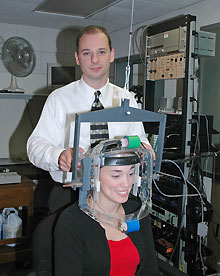For more archives, go to the Advance Archive/Search Page.
Research On Stuttering Explores
Motor Control, Medication
Ludo Max believes that stuttering may be the most psychologically painful speech disorder there is.
Max, an assistant professor-in-residence of communication sciences who specializes in stuttering, has heard of people who have moved to different addresses because their street name was too difficult for them to articulate; others who have picked certain names for their children because the initial consonants could be pronounced clearly most of the time; and others who chose their majors in college based on avoiding certain words or selected a particular career in order to keep their stuttering hidden.
People who stutter really organize their lives around it, Max says, and yet so little is known about the condition, which afflicts one percent of the population.
Some researchers believe that stuttering is a cognitive issue, an inability to put sounds into the correct order before they are produced. Others argue that stuttering is a lexical access problem – that it is a matter of selecting the words from some sort of lexicon in the brain. Max himself is among the researchers who believe that stuttering is fundamentally a motor problem. After all, speech requires the use and sophisticated coordination of an estimated 100 muscles. Moreover, Max and other investigators have shown that individuals who stutter demonstrate differences in control and movement parameters not only in the motor systems used for speech, but also in unrelated motor systems.
 |
|
Ludo Max, assistant professor-in-residence in communications sciences,
puts an articulograph, used to measure movements of thelip and
tongue during speech production, onto Marie Wallace, a graduate
student specializing in communication disorders. |
Motor Control
In his quest to understand the motor aspects of speech, Max has conducted research
with fluent speakers as well as stutterers. His latest research addresses
the relationship between dopamine levels in the brain and motor control. Brain imaging
research has shown that people who stutter have about twice as much dopamine in
the brain as people who don’t. When given medication that blocks dopamine,
subjects who stutter tend to produce more fluent speech.
The problem with this pharmacological solution, Max says, is that if the dopamine levels go too low, the subjects will show some of the same motor control issues exhibited by people with Parkinson’s disease, an illness characterized by a lack of dopamine.
In Max’s current clinical trial, conducted in collaboration with Drs. Nicholas A. DeMartinis and Andrew Winokur of the UConn Health Center, researchers are giving adults who stutter a drug that has the capacity to both lower dopamine levels and maintain them at more ideal and stable levels.
A Combined Approach
All the subjects in the study will participate in sensory-motor experiments
both before they begin the medication and while they are taking it. Max
will employ two high-tech devices to better understand the effects of the medication
on speech fluency.
The first is the articulograph, which measures the movement of the lips, tongue, and jaw as speech is produced. This is not as easy as it sounds. Subjects must first have their tongues dried with a hairdryer so that small transducers can be secured to the tongue, lip, and jaw with a dental adhesive. Subjects then don a plexiglass halo-helmet (it looks like a prop in a horror movie or sci-fi film) that uses three coils to produce an electromagnetic field around the head.
In the presence of this electromagnetic field, the transducers create a voltage that enables the articulograph to track their movements. While the subject speaks, the articulograph determines the exact position of each transducer in space, thus measuring the extent and duration of movements, and how the lips, tongue, and jaw are working together to produce specific sounds.
Max’s second piece of equipment is a computer-controlled robotic arm that is secured to a person’s jaw via an orthodontic appliance. Optical encoders in the arm and a transducer attached to the appliance enable the computer to precisely track and analyze the jaw’s movement. As the person articulates words or syllables, the robot applies small forces to the jaw, for example, consistently pulling the jaw a bit forward or giving a tap on the jaw to alter one individual movement. Studies by other researchers have shown that this sensory input causes the speaker to make adjustments in order to produce the desired sounds or syllables – in the way that a pilot flying north must compensate for a strong west wind in order to maintain a straight course.
Says Max, “We can study to what extent the movement trajectory is altered and to what extent the subject was able to compensate and perform more normal movements.”
His theory is that individuals who stutter may have difficulties specifically with planning the necessary motor commands that will achieved a sequence of desired sensory consequences. The experiment is designed to determine how adults who stutter will relearn the necessary motor commands when the normal sensory consequences are altered by the robot.
Although others have done trials with drugs that affect dopamine metabolism in people who stutter, Max and his colleagues are the first to combine the medication with the sensory-motor experiments. Max recognizes that the experiments are somewhat invasive, but he notes that people who stutter are very motivated, not only to help themselves, but also to help others in the future who might benefit from what is learned.
Max, who says he became interested in stuttering because it was the least understood of speech disorders, says the challenges that attracted him to doing research on stuttering in the first place are still present. “We don’t know what causes it,” he says, “and we don’t what is the best way to treat it.”

